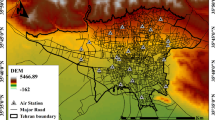Abstract
A new concept of urban environmental entropy was introduced to investigate the effect of urbanization on air environment considering the fact that rapid development of urbanization may have negative influence on the whole air environment system. The urban environmental entropies which were built based on the generalized thermodynamic entropy and the generalized statistic entropy, respectively. These two entropy models have been used to analyze the relationship between the development of urbanization and air environment. The negative entropy flow mechanism was proposed to reveal the advantages and approaches of regional cities in improving air environment system. A case study on 17 cities in Shandong Province of China showed that the values of urban environmental entropy were negative in most cities from 2001 to 2008, which implies that there is a positive correlation between the development of urbanization and air environment and that is a negative entropy development level in Shandong Province of China. In 2008, the urbanization of Qingdao city and Jinan city improved their air environments. Moreover, restraints for both cities in air environment improvement were recognized according to the analysis of negative entropy flow mechanism.

Similar content being viewed by others
References
Allan J (2002) Entropy and the cost of complexity in industrial production. Int J Exergy 2(4):295–299
China network (2009) The probability of occurrence for hidden events of air pollution in China. http://www.china.com.cn/policy/txt/2009-04/23/content_17655398.htm (in Chinese)
Fang CL, Yang YM (2006) Basic laws of the interactive coupling system of urbanization and ecological environment. Arid Land Geogr 29(1):1–8 (in Chinese)
Feng WB (2007) Study on the Inter-relationship between Urbanization and Eco-environment. Res Soil Water Conserv 14(1):92–94 (in Chinese)
Grossman GM, Krueger AB (1995) Economic growth and the environment. Q J Econ 110:353–378
Hai RT, Yang ZF (1986) Study on the sustainable development of urban environment. Environ Sci 6(6):22–48
Huang JC, Fang CL (2003) Analysis of coupling mechanism and rules between urbanization and eco-environment. Geogr Res 22(2):211–219 (in Chinese)
Jowsey E (2009) Economic aspects of natural resource exploitation. Int J Sustain Dev World 16(5):303–307
Kasemsan M, Park SK, Russell AG (2008) Accounting for high-order correlations in probabilistic characterization of environmental variables, and evaluation. Stoch Environ Res Risk Assess 22(2):159–168
Larry LS, Woosley JK (1999) Application of steady state maximum entropy methods to high kinetic energy impacts on ceramic targets. Int J Impact Eng 23(1):869–882
Liu YB, Li RD (2005) Analysis of coupling degrees of urbanization and ecological environment in China. J Nat Resour 20(1):105–112 (in Chinese)
Long RW, Eatough NL, Mangelson NF et al (2003) The measurement of PM2.5, including semi-volatile components, in the EMPACT program: results from the Salt Lake City Study. Atmos Environ 37(31):4407–4417
Ning ZX (1998) Handbook of food composition analysis. China Light Industry Press, Beijing (in Chinese)
Northam RM (1975) Urban geography. Wiley, New York
OECD (1998) Towards sustainable development: environmental indicators. Organization for Economic Cooperation and Development, Paris
OECD (1999) Environmental indicators for agriculture. Volume 1: concepts and frameworks. Organization for Economic Cooperation and Development, Paris
Ouyang TP, Fu SQ, Zhu ZY et al (2008) A new assessment method for urbanization environmental impact: urban environment entropy model and its application. Environ Monit Assess 146:433–439
Rinehart LR, Fujita EM, Chow JC et al (2005) Spatial distribution of PM2.5 associated organic compounds in central Californian. Atmos Environ 40(2):290–303
Robert G, Brigitte B (2003) Characterizing seasonal variations and spatial distribution of ambient PM10 and PM2.5 concentrations based on long-term Swiss monitoring data. Atmos Environ 37(19):2571–2580
Shandong Provincial Bureau of Statistics (2010) Shandong provincial statistic yearbook 2010. China Statistical Press, Beijing (in Chinese)
Shandong Provincial Environmental Protection Bureau (2010) Annual environmental quality report 2010, Jinan (in Chinese)
Tomas K, Bengt M (2001) Entropy and economic processes-physics perspectives. Ecol Econ 36(1):165–179
Wang RS (1988) High efficiency and harmony-principles and methods of urban ecological regulation. Hunan Education Press, Changsha (in Chinese)
Wu ZB, Li W, Wang LH (2003) Introduction to the urban air environment. Chemical Industry Press, Beijing (in Chinese)
Yu HL, Yang SJ, Yen HJ et al (2011) A spatio-temporal climate-based model of early dengue fever warning in southern Taiwan. Stoch Environ Res Risk Assess 25(4):485–494
Zong YG (1993) Landscape planning theory and method. Science China Press, Beijing (in Chinese)
Acknowledgments
This research is supported by National Natural Science Foundation of China (No. 30900047) and Humanities & Social Sciences Project, Ministry of Education (No. 10YJCZH209).
Author information
Authors and Affiliations
Corresponding author
Rights and permissions
About this article
Cite this article
Wang, Q., Yuan, X., Ma, C. et al. Research on the impact assessment of urbanization on air environment with urban environmental entropy model: a case study. Stoch Environ Res Risk Assess 26, 443–450 (2012). https://doi.org/10.1007/s00477-011-0493-5
Published:
Issue Date:
DOI: https://doi.org/10.1007/s00477-011-0493-5




